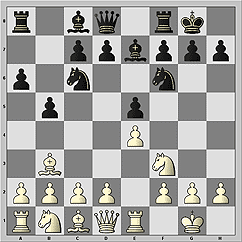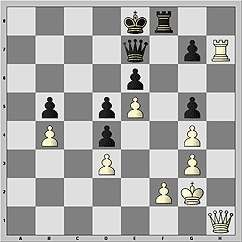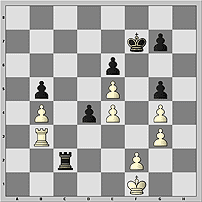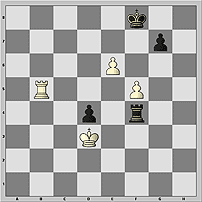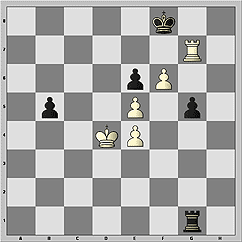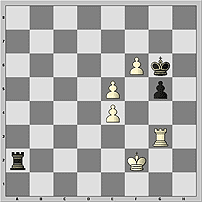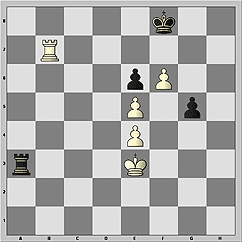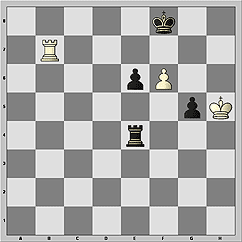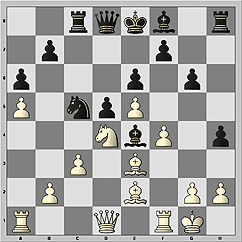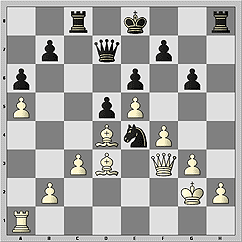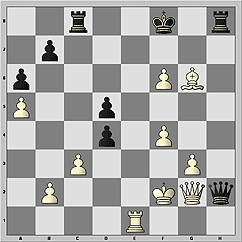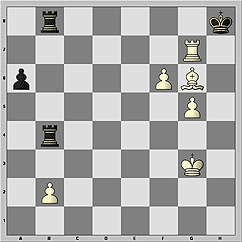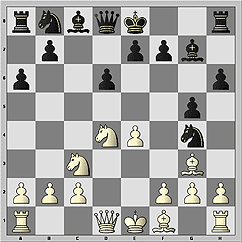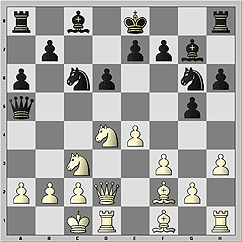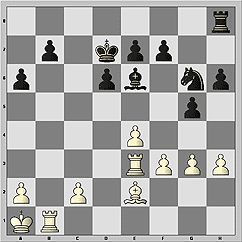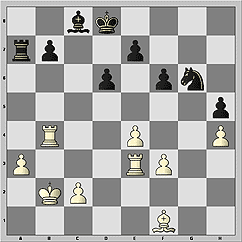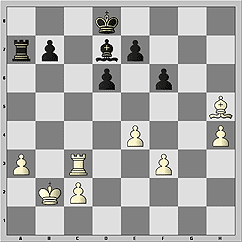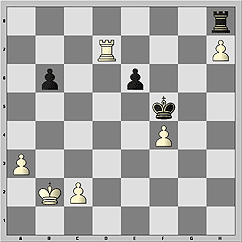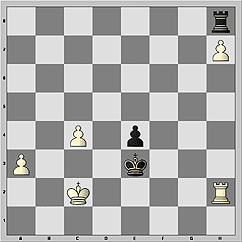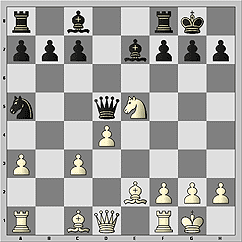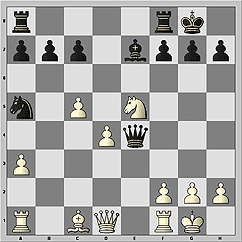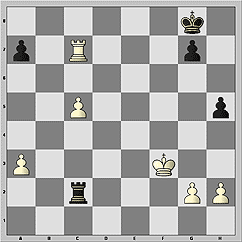 | Последние турниры |
Чемпионат России
СуперФинал

02.12.2006
Суперфинал чемпионата России проходит в Москве, в ЦДШ им. М.М.Ботвинника со 2 по 15 декабря при 12 участниках по круговой системе.
Крамник - Fritz

25.11.2006
С 25 ноября по 5 декабря в Бонне чемпион мира Владимир Крамник сыграет матч из 6 партий с программой Deep Fritz. В случае победы Крамник получит 1 миллион долларов, тем самым удвоив свой стартовый гонорар ($500000).
Мемориал Таля

5.11.2006
В Москве с 5 по 19 ноября проходил Мемориал Таля, в программе которого супертурнир 20-й категории и выдающийся по составу блицтурнир. Призовой фонд каждого состязания - 100.000 долларов.
Топалов - Крамник

23.09.2006
После того как "основное время" не выявило победителя (счет 6:6), 13 октября соперники сыграли 4 дополнительных поединка с укороченным контролем времени.
Томск. Высшая лига

2.09.2006
Со 2 по 11 сентября Томск принимает Высшую лигу чемпионата России 2006 года. В турнире участвуют 58 шахматистов - как получившие персональные приглашения, так и победившие в отборочных состязаниях.
Майнц

17.08.2006
В последние годы фестиваль в Майнце вслед за "Амбер-турниром" стал центром легких шахматных жанров. Наряду с массовыми ристалищами традиционно проходят чемпионские дуэли.
Россия - Китай

10.08.2006
С 10 по 20 августа в Китае проходит товарищеский матч сборных России и Китая. В нынешнем поединке как мужчины, так и женщины соревнуются на пяти досках по шевенингенской системе в два круга.
Все материалы
ChessPro

|
|

|
|
 |
Сергей ШИПОВ,
гроссмейстер |
Snow White and Seven Dwarfs |
You know, this title is better than. The Wolf and the Seven Young Kids! I don’t mean offending anyone. There is one problem though. It is hard to imagine Topalov in the role of Snow White. He is rather a real sharp-toothed, fierce wolf! He devoured all his seven rivals. I don’t think Anand took comfort in the fact that he was the only participant to withstand the predator’s aggression. This half point will make him no good.
On the other hands dwarfs are sturdy guys, not easy to beat. They work slowly but diligently and can pick up. By the way, seven young kinds from Grimm Brother’s fairy tale stood up for themselves and rebuffed the wolf! It is too early to drop the curtain. Let’s wait for the second part of the event.
The GMs celebrated the end of the first round with an impressive performance. It was another round with all decisive games. This time White “whitewashed” black 4-0.
The number of pursuers is reduced to just one. Only Peter Svidler has a chance to fight for the title if he has very good cards in hand and luck on his side.
Vengeance is unworthy of a noble man, but how sweet it is! Veselin was eager to gain revenge for his defeat in semi-final of FIDE Championship (2004) in Livia at the hands of Kasimdzhanov. All four classical games were drawn whereas the rapid chess mini-match saw Rustam win. Ultimately, he won the event. The retribution time came…
Ruy Lopez C88
Veselin TOPALOV (BUL) – Rustam KASIMDZHANOV (UZB)
1.e4 e5 (as Topalov is extremely good in the Sicilian Defense on both sides, it was not very difficult to predict that Rustam would play some more solid opening) 2.Nf3 Nc6 3.Bb5 a6 4.Ba4 Nf6 5.0-0 Be7 6.Re1 b5 7.Bb3 0-0.
8.h3 (the Anand – Svidler game demonstrated that in the Marshall attack Black is safe and sound) 8...Bb7 9.d3 d6 10.a3 Na5 11.Ba2 c5 12.Nbd2 Nc6 13.Nf1. White follows well-knon patterns. His pieces are slowly but surely flowing to the kingside.
13...Bc8! This transfer of the light-squared bishop to e6 became Black’s stronghold in this line. The white light-squared bishop pressure on d5 square is offset by his Black colleague.
14.c3 Be6 15.Bxe6 fxe6 16.b4. If White does not launch active operation on the queenside, Black breakthroughs in the center: 16.Ng3 Nd7 17.Be3 d5!? 18.exd5 exd5 19.a4 Rb8 20.axb5 axb5 21.b3 Ra8, draw Kasparov – Topalov (Linares 2005)
16...Qd7. Formally speaking that is a novelty. In the game (Adams – Kasimdzhanov, Linares 2005) Black took and different approach but in my opinion failed to equalize completely: 16...Nh5 17.N1h2 Nf4 18.Bxf4 Rxf4 19.Qb3 Qd7 20.a4! bxa4 21.Rxa4 cxb4 22.cxb4 Rb8 23.Rea1 Rb7 24.Rxa6 Nxb4 25.Ra8+ Rf8 26.Rxf8+ Bxf8 27.Rb1 Rb8 28.Qc4 d5 29.Qc3 Rc8 30.Qb3 – despite numerous exchange Black still have some problems, as his central pawns are vulnerable.
17.Qb3.
17...Rfb8!? The game is taking an interceding turn. Black manifest his intentions. He is going to strike on the queenside first. Although he eventually lost the game, I like this idea.
18.N1h2 (With the black pawn on e6 transferring the knights to e3 or g3 makes no sense) 18...a5 19.Bd2! Correct reaction! The wave of black pawns is stopped on b4. This breakwater is as hard as a rock. The sequence 19.bxc5 a4! 20.Qa2 dxc5 favors Black.
19...h6 20.Ng4. Starting from this moment the questions arise. I can’t understand why should Black trade the knights on g4. Let White do so on f6!
20...Nxg4. Immediate exchanges deserved a closer look: 20...axb4 21.axb4 cxb4 22.cxb4 and here along with 22...Kf7 Black has one more option – 22...Nh7!? – transferring the knight to f8 and freeing the queen for more important business.
21.hxg4. Now White has a structural advantage on the kingside. The blow g4-g5 will be a constant threat. Besides, Veselin convincingly proved that White can employ the open h-file quickly and effectively.
21...axb4 22.axb4 cxb4 23.cxb4 Bf6 24.Rec1 (Whtie is doing good job pretending that he has no interests on the kingside) 24...Kf7. Quite reasonable decision. As a defender the queen is good-for-nothing. It is much better to use this powerful piece for creating threats. In this particular case with the help from his queen Black can trade the rooks.
25.g3! Qb7 26.Kg2 Rxa1 27.Rxa1 Ra8.
Frankly speaking, I was under impression that with such a huge gap between the leader and his closest pursuers Topalov would not break a lance in this game. All the more I was impressed when I saw 28.Rh1! That is what I call champion’s maximalism!
28...Nd4?! (another inaccuracy: removing the f3-knight Black is playing into White’s hands) 29.Nxd4 exd4 30.Bf4 (Black did not pass this test) 30...d5?! This move leads to big troubles. More stubborn was 30...Be7! For example 31.Rh5 Qc6 and the check from f5 is not dangerous for Black.
31.e5! The pawn structure has changed to White’s favor. Probably Rustam counted on something like 31.exd5 Qxd5+ 32.Qxd5 exd5 33.Rc1 Ra3= or 31.Rc1 Rc8 32.Rxc8 Qxc8 33.exd5 e5! Indeed, Black is OK in these lines.
31...Be7 32.Qd1! (Black is threatened with g4-g5! In some lines White may sacrifice the bishop for a dangerous attack) 32...Bg5. I don’t know whether I should put the mark "?!" for the third time in a row. Black has problems in all the lines. For example 32...Kg8 33.g5 hxg5 34.Qg4! Qc6 35.Bxg5 and the capture 35...Bxb4 fails to 36.Qh5 Bf8 37.Qh7+ Kf7 38.Rh4!; The solid shield 32...g5 is shattered with an impressive 33.Rxh6! gxf4 34.Qh1 and the black king has to runaway leaving his subjects to the mercy of fate – 34...Ke8 35.Rxe6 Qc8 (35...Kd7 36.Rxe7+!) 36.Qh5+ Kd7 37.Qf7 Qf8 38.Rxe7+! Qxe7 39.Qxd5+ and the curtain falls.
33.Bxg5 hxg5 (Black has three weaknesses: the pawn g5, d4, and his own king; naturally first of all he had to take care of his monarch) 34.Rh5 Qe7 35.Qh1! The h-file became the road to victory for White. I am sure that at this point Rustam recalled his trade of the knighst on g4.
35...Rf8 (the black king is ready for an escape) 36.Rh7 Ke8/ That is one of the critical moments. I think too much time on the clock did the Bulgarian GM a disservice. He wanted to play the best move, but committed an inaccuracy.
37.Qa1. Wrong direction of the attack. Had been White in time trouble he would have stuck to the main attacking line – 37.Qh5+ Kd8 (37...Kd7 38.Qg6 Rg8 39.f4!) 38.Qg6 Rg8. Here White should insert 39.Kh3 and then carry out f2-f4-f5.
37...Kf7 38.Qc1 Ke8 39.Qa1 Kf7 40.Qxd4 (Topalov made his choice with the last move before the time control; it was not too late to return to the right path – 40.Qh1! Ke8) 40...Kg8 41.Rh1 Qf7. Somewhat unexpectedly it turned out that Black had perfectly arranged his pieces and launched a dangerous counterattack.
42.Qe3. There is no White’s victory in sight after 42.Rf1 Qf3+ 43.Kg1 Kh7! Check out a possible although not compulsory line – 44.Qb6 Rf4! (Black reacts the same way on 44.Qc5) 45.Qxe6 Rxg4 46.Qd7 (46.Ra1 Rxg3+!=) 46...Rxb4 47.Re1 (47.Qh3+ Rh4 48.Qg2 Qxg2+ 49.Kxg2 Rd4=) 47...Rb2! 48.Qa7 Qxd3 49.e6 Rb1 50.Rxb1 Qxb1+ 51.Kh2 Qg6 52.e7 (52.Qf7 b4!; 52.Qd7 Qc2 53.Qf7 Qg6!=; 52.Qe3 d4 53.Qe5 d3 54.e7 d2=) 52...Qe8 53.Qe3 (53.Qc5 Kg6!) 53...g4 54.Qe5 g6 55.Qf6 Kg8
Black king is just in time to support his queen. There won’t be any third queen on the board! Certainly, there are many other options…
42...d4! 43.Qe2 Qb7+ 44.Qe4. It is hard to venture upon loosening the second rank. After 44.f3 Ra8 (44...Qc6!?) 45.Rc1 Qd5 46.Rc2 Ra1 Black has a good counterplay.
44...Qxe4+ 45.dxe4 Rc8. Black is first to activate his rook. Therefore he equalizes the position. From this moment on Topalov played extremely well and figuratively speaking won the game for the second time!
46.Rb1. Woeful necessity. In the line 46.Ra1 Rc4 47.Ra8+ Kf7 48.Ra7+ Kf8 49.Rb7 Rxb4 50.f4 Black easily holds: 50...d3 (или 50...Rb2+ 51.Kf3 Rb3+ 52.Kf2 Rb2+ 53.Ke1 Rg2) 51.Rd7 Rxe4 52.Kf3 Rc4 53.Rxd3 g6!? and so on.
46...Rc3. This natural move is not the only one. Probably it is even better to keep the rook on the second rank – 46...Rc2!? 47.Kf1 (47.Rb3 Re2 48.Kf3 Rc2) 47...Kf7 (47...d3? 48.Kg2!) 48.Rb3
At this point Black should lure the white king to e1 – 48...Rd2! (выжидать королем опасно – 48...Ke7 49.f4!) 49.Ke1 (inferior is 49.f4 d3! и Rd1-e2; the sequence 49.f3 Kf8 50.Ke1 Rc2! is no better for White) 49...Rc2, and White can’t breakthrough with 50.f4 in view of 50...gxf4 51.gxf4 g5! 52.f5 Rg2 with a totally equal position. With the rook on f1 this trick does not work as the black rook has no access to g2-square.
47.Rb2! (now White can transfer his king to the center) 47...Kf7 (47...Rc1 48.Kf3!) 48.Kf1.
48...Rc1+. I think Black should have advanced his pawn to g6. In this case White’s plan that he implemented in the game does not work – 48...g6! 49.Ke2 Kf8 50.Ra2 Rb3 51.Ra8+ Kf7 52.Ra7+ Kf8 53.Rb7 Rxb4 54.Kd3 Rb2 55.f4 gxf4 56.gxf4 Rf2! – and the f5-square is under Black’s control. Draw is inevitable.
49.Ke2 Rc3 50.Ra2! (the only but good chance to push for victory) 50...Rb3 51.Ra7+ Kf8 52.Rb7 Rxb4 53.Kd3. White had enough time to bring his king into play.
53...Rb2 (temporizing tactics does not help – 53...Kg8 54.f4 Rb3+ 55.Kxd4 Rxg3 56.f5 Rxg4 57.f6!) 54.f4.
54...Rb3+. Rustam complicated this task in the time trouble. It looks like better was 54...gxf4! 55.gxf4 Rg2 and here 56.f5 (the following variation lead to a simple draw 56.g5 Rg4 57.Kxd4 Rxf4 58.Kc5 Rg4! 59.Kd6 Rxg5 60.Kxe6 Rg6+ 61.Kd5 Ra6 etc.) 56...Rxg4 57.Rxb5 exf5 ( 57...Rg5? is a wrong track 58.Kxd4 exf5 59.Kd5!+-; there is no refutation of 57...Rf4) 58.exf5 Rf4 59.e6
Here Black just wait as White can’t make further progress – 59...Ke8 60.Kc4 Kf8 61.Rb8+ Ke7 62.Rb7+ Ke8 63.Rf7 Rg4! (63...Kd8? 64.Kd5 d3 65.Rxg7 Rxf5+ 66.Kd6+-) 64.Rb7 Rf4=
55.Kxd4 Rxg3 56.f5! Rxg4 57.f6! Rg1! (the continuaiton 57...gxf6? 58.exf6 is hopeless. Black can’t allow the white king to e5) 58.Rxg7.
58...b4? Probably only this move changed the evaluation of this position. Black’s last chance lay in 58...Rc1! For example 59.Rxg5 Rc4+ 60.Kd3 (60.Ke3 b4 61.Rg7 b3 62.Rb7 Rc3+ 63.Kd4 Rh3 64.Kc5 Rd3 65.Kc4 Re3=) 60...Rc5 61.Rh5 (61.Ke3 Rc3+ 62.Kf4 b4=) 61...Kg8! (61...b4? 62.Kd4 Rc1 63.Rh8+ Kf7 64.Rh7+ Kf8 65.Rb7+–) 62.Ke3 Rc3+ 63.Kf4 b4! and Black holds the position.
The winning method that brought White victory in the game does not work here – 58...Rc1 59.Rb7 Rc4+ 60.Ke3 Rc3+ 61.Kf2 Rc5 62.Kf3, it is very important to get rid of the g-pawn – 62...g4+! 63.Kxg4 (63.Kf4 g3 64.Rg7 Rc3) 63...Rxe5 64.Kf4 Rc5 65.Re7 (65.e5 Rc4+ 66.Kg5 b4=) 65...b4 66.Rb7 (66.Rxe6 Rb5=) 66...Rh5! 67.Kg4 (67.e5 Rh4+ 68.Kg5 Re4=; 67.Rxb4 Kf7=) 67...Re5 68.Kf3 Rc5 69.Kg4 Re5 70.Kf4 Rh5 and White can’t do anything.
59.Kc5! (Black is losing his passer) 59...b3 60.Rb7 Ra1 (60...Rg3 61.Kd6!) 61.Rxb3 Ra5+.
62.Kd4! White took the shortest path to the victory. There was the longer one – 62.Kd6 Ra6+ 63.Kd7 Kf7 64.Rg3 Ra7+ 65.Kc6 Kg6 66.Kd6 Ra6+ 67.Ke7 Ra7+ (67...Rb6 68.Rf3!) 68.Kxe6 Ra6+ 69.Kd5 Ra5+ 70.Kd4 Ra4+ 71.Ke3 Ra3+ 72.Kf2 Ra2+
73.Kg1! (but not 73.Kf3? Ra5) 73...Ra1+ (73...Ra5 74.Rf3 Kf7 75.e6+!) 74.Kh2 and the game is over.
62...Ra4+ 63.Ke3 Ra5 64.Rb8+ Kf7 65.Rb7+ Kf8 (65...Kg6 66.Rg7+ Kh6 67.Rg8 Ra7 68.Re8+–) 66.Kd4 Ra4+ 67.Kc5. This repetition does not change anything
67...Ra5+ 68.Kd4 Ra4+ 69.Ke3 Ra3+. It is time to execute the plan.
70.Kf2! Ra5 71.Kg3 Rxe5 (the material is equal but it is poor consolation for Black) 72.Kg4! Rxe4+ 73.Kh5! The white king is marching to g6. Black will have to give up his rook for the f6-pawn. His own g5-pawn screens the white king from the rear check. Black resigns
This grandiose battle took the whole night of my life. I did not have enough time for detailed annotation of other games!
Caro-Kann Defense B12
Alexander MOROZEVICH (RUS) – Vishwanathan ANAND (IND)
1.e4 c6 2.d4 d5 3.e5 Bf5 4.Nf3 e6 5.Be2 Ne7 6.Nbd2 h6 7.0-0 Nd7 8.c3 a6 9.Nb3 Rc8. It’s one of the most popular lines of Caro-Kann Defense with heavy French accent. The pawn structure resembles that of the French Defense.
10.Nh4. Novelty. Blitz-game between two popular players saw 10.g3 Bh7 11.h4 c5 12.Nxc5 Nxc5 13.dxc5 Rxc5 14.Qb3 Qd7 15.Be3 Rc8 16.c4 Be4 17.Nd2 Nf5 18.Nxe4 dxe4 19.Rfd1 Qc6 20.Bg4 Nxe3 21.Qxe3 Bc5 22.Qe2 0-0 and Black equalized (Rublevsky – Bareev, Internet, 2004)
10...Bh7 11.f4 c5 12.Bh5 Nf5 13.Nxf5 (it’s impossible to avoid knight exchange – 13.Nf3? c4! 14.Nbd2 Ne3–+) 13...Bxf5 14.Be3 g6 15.Be2 h5 16.dxc5 Nxc5 17.Nd4 Be4 18.a4 h4 19.a5. Here Vishy started to play sharply making his opponent very happy!
19...h3 20.g3 Bg2 21.Rf2!? (good exchange sacrifice) 21...Ne4 22.Rxg2 hxg2 23.Kxg2. I believe in this position black rooks are no better than white light pieces as the pawn fences stretch all-over the board.
23...Bc5 24.Bd3 Qd7 25.Qf3 Bxd4 26.Bxd4. Here Anand probably miscalculated something as his ensuing moves led to a collapse.
26...f5? (26...Qc6!) 27.exf6 e5 (this is Black’s idea – his queen is going to visit white king) 28.Bxe4 Qh3+ 29.Kf2 Nobody dies from a check!
29...Qxh2+ 30.Qg2 (and from two checks…) 30...exd4 (the best option) 31.Bxg6+ Kf8 32.Re1! Black’s attack is over; it’s time to sober up. White bishops and pawns are much stronger than a black rook.
32...d3 33.Bxd3 Rc6 34.Re5 Rd6 35.Kf3 Qxg2+ 36.Kxg2 Rh6 37.g4 Rhxf6 38.f5 Rf7 39.Kg3. White pawns are unstoppable. Black’s counterplay on the queen side can’t change anything.
39...b5 40.axb6 Rxb6 41.g5 Rd7 42.f6 d4 43.Bg6 Rb8 44.cxd4 Rxd4 45.Re7 Rdb4 46.Rf7+ Kg8 47.Rg7+ Kh8.
48.Bf7! (last subtlety; White is sewing the checkmate shroud to the black king) 48...Rd4 49.Rg6 Rd3+ 50.Kg4. Black resigns.
Sicilian Defense B90
Peter SVIDLER (RUS) – Judit POLGAR (HUN)
1.e4 c5 2.Nf3 d6 3.d4 cxd4 4.Nxd4 Nf6 5.Nc3 a6 6.Be3 Ng4 7.Bg5 h6 8.Bh4 g5 9.Bg3 Bg7. This variation of Najdorf surprisingly became one of the most popular in this tournament. Make no mistake, everybody will start playing this line after the event. Top players kings set trends and dictate chessic fashion...
10.h3 Ne5 11.f3 (another try. Svidler played 11.Nf5 against Topalov bad had no luck) 11...Nbc6 12.Bf2 Ng6. White got the upper hand after 12...Be6 13.Qd2 Qa5 14.Nb3 Bxb3 15.cxb3 Nb4 16.a3 Ng6 17.Rd1 Nc6 18.Nd5 Qxd2+ 19.Rxd2 0-0 20.b4 in the Leko – Kasparov (Linares 2000) game.
13.Qd2 Qa5 14.0-0-0.
14...Bd7. Novelty. A new plan, a new setup. Earlier Black placed the bishop on e6 and reached quite comfortable positions. For example, 14...Be6 15.Kb1 Rc8 16.Nb3 (or 16.Nd5 Qxd2 17.Rxd2 Nxd4 18.Bxd4 Bxd4 19.Rxd4=) 16...Bxc3 17.Nxa5 Bxd2 18.Nxc6 Rxc6 19.Rxd2 f6 20.b3 Kf7, and White has only a slight advantage (Tiviakov – Dominguez, Wijk aan Zee 2004).
15.Kb1 Rc8 16.g3! Slowly Svidler starts active play. Or just pretends that he is going to be active! Black has only one problem – there is no safe place for the king. And it’s impossible to find it!
16...Nxd4 17.Bxd4 Bxd4 18.Qxd4 Qe5 19.Qf2! Of course, White shouldn’t exchange queens.
19...Rxc3. Polgar has no desire a passive defense. She opted for an exchange sacrifice, but she doesn’t obtain sufficient counterplay.
20.bxc3 Qxc3 21.Rd3 Qa5 22.Qe3 Be6 23.Ra3 Qb4+ 24.Ka1 Kd7 25.Be2 Qc5 26.Rb1 Qxe3 27.Rxe3. The endgame was played brilliantly by Svidler.
27...Rb8 28.Bxa6 Ra8 29.Bb5+ Kd8 30.a3 h5 31.Bf1 Ra7 32.Rb4 Bc8 33.Kb2 f6 34.h4!? gxh4 35.gxh4.
35...Bd7 (there was a nice line here – 35...Nxh4 36.e5 Nf5 37.exf6! Nxe3? 38.f7+–) 36.Reb3 Bc8 37.Rb5 Nf4 38.Bc4 Kc7 39.Bf7 Bd7 40.Rc3+ Kd8 41.Rxh5! (classical example of converting) 41...Nxh5 42.Bxh5. White passer is extremely dangerous.
42...e6 43.Bg6 Bc6 44.h5 Ke7 45.f4 Ra8 46.h6 Rh8 47.h7 f5 48.exf5 Kf6 49.Rd3 Be4 50.Rxd6 Bxf5 51.Bxf5 Kxf5 52.Rd7 b6. Don’t believe Tartakower! There are rook endgames that can be won. For example, those with two extra pawns...
53.Rf7+ Kg6 54.Rb7 Kf5 55.c4 Kxf4 56.Rxb6 e5. After 56...Rxh7 57.Rxe6 the endgame with “a” and “c” pawns arises. With a king on b7 it will be a draw, but in this case black king is cut off by a white rook.
57.Rh6 e4 58.Kc2 Ke3 59.Rh2.
Black pawn can’t advance. White places its king in front of it and easily wins. Black resigns.
Where did Polgar make a mistake? She made no real mistakes! The choice of the opening was wrong, Peter played well and the queen of chess herself got a bit tired...
Petroff Defense C42
Peter LEKO (HUN) – Michael ADAMS (ENG)
1.e4 e5 2.Nf3 Nf6 3.Nxe5 d6 4.Nf3 Nxe4 5.d4 d5 6.Bd3 Nc6 7.0-0 Be7 8.c4 Nb4 9.Be2 0-0 10.a3 Nc6 11.cxd5 Qxd5 12.Nc3 Nxc3 13.bxc3 Na5 14.Ne5. This position is quite popular.
14...Bf5. Strangely enough, but such a natural move is a novelty. However, after this game nobody will dare to repeat it. There are plenty possibilities for Black here – for example, 14...Bf6, 14...Qb3 or 14...c5.
15.c4 Qd6 16.c5. Black should be cautious here and retreat the queen to f6. But Michael wanted to know what trap had been prepared for his queen in the centre…
16...Qd5? (16...Qf6!) 17.Bf3 Be4 18.Bxe4 Qxe4.
19.Bd2! (probably, the Englishman overlooked this move; it turned out that White can leave d4 pawn without defense) 19...Nc6. After 19...Qxd4? 20.Nf3 Qxc5 21.Bb4 Black loses a piece.
20.Re1 Qh4 21.Nf3 Qh5 22.Rb1! Bf6 (22...b6 is bad in view of 23.cxb6 cxb6 24.Rc1 Rac8 25.Rxc6 Rxc6 26.Rxe7) 23.Rxb7 Nxd4 24.Nxd4 Qxd1 25.Rxd1 Bxd4 26.Be3 Bxe3 27.fxe3. Once again a winning rook endgame. It was not a Tartakower’s day…
27...c6 28.Rd6 Rae8 29.Kf2 Re5 30.Rxc6 Rfe8 31.Rcc7 Rxe3 32.Rxf7 Re2+ 33.Kg3 R8e3+ 34.Rf3 Rxf3+ 35.Kxf3 Rc2 36.Rc7 h5.
37.c6! Kh7 38.h3 Kh6 39.Ke4! Kg6 and Black resigns in view of obvious 40.Kd5.
Standings after seventh round: 1. Topalov – 6.5 (Kasparov’s rating record is in danger); 2. Svidler – 4.5 (Peter – is a modest person, but he should forget about this feature); 3–4. Leko and Anand – 3.5 (these guys have a good position for a spurt, but they should hurry up…); 5–6. Morozevich and Kasimdzhanov – 3 (Alexander as a noble person must win all seven games. Otherwise why did he stop Vishy? ); 7–8. Polgar and Adams – 2 (Michael and Judit can relax and enjoy chess. To go down in history it is enough for them to beat Topalov in the second round.)
|
|

